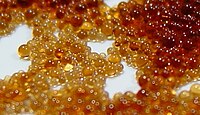
Photo from wikipedia
Abstract Membrane chromatography is an emerging bioprocessing technology. This work aimed to determine the cause of pressure rise during the loading phase of a large-scale viral recovery process, through small-scale… Click to show full abstract
Abstract Membrane chromatography is an emerging bioprocessing technology. This work aimed to determine the cause of pressure rise during the loading phase of a large-scale viral recovery process, through small-scale experimentation. Comparable pressure rise was observed at both small and large scales, using Sartobind® Q anion exchange membranes. By varying low rate and feed concentrations of virus and host cell DNA, a linear relation between Viral Dynamic Dynamic Binding Capacity (DBC) and pressure rise was observed when DNA levels exceeded 1 × 10−8 g/ml. A mathematical model, assuming an uncompetitive interaction between the two species in a representative pore, was developed to predict breakthrough from which DBC and then pressure rise was determined. The results matched experimental data quite well at low to moderate DBC values (ie
Journal Title: Chemical Engineering Science
Year Published: 2021
Link to full text (if available)
Share on Social Media: Sign Up to like & get
recommendations!